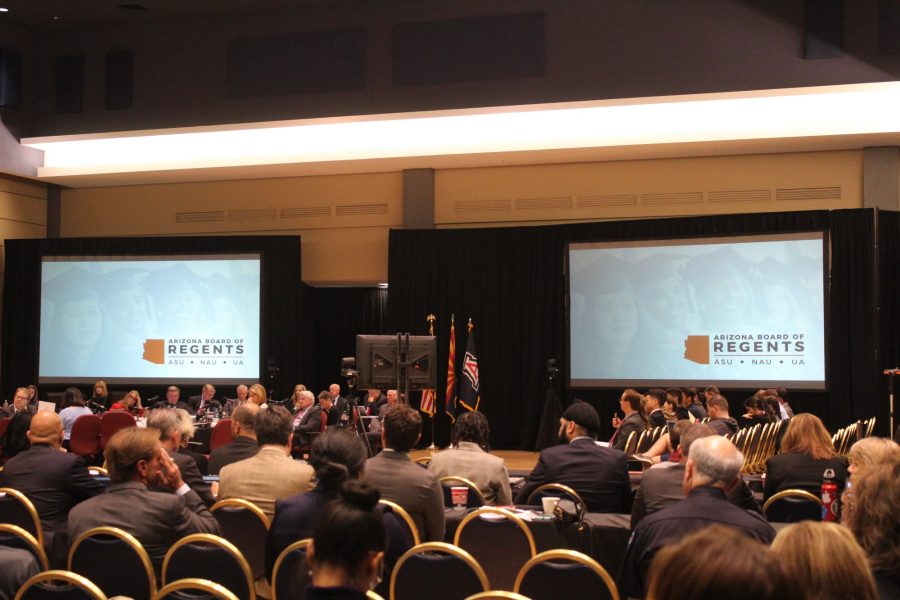The Arizona Board of Regents heard from the University of Arizona’s President Dr. Robert C. Robbins about financial plans for the future of university at the Nov. 22 meeting in the Student Union Memorial Center.
Robbins highlighted recent achievements from the university and announced the College of Medicine in Phoenix and Tucson is receiving $8 million in recurring funding.
RELATED: Regents Recap Day 1: Native American students speak out, Robbins’ contract extended
According to a press release from the Governor’s office, the university will provide free tuition to students who agree to practice in medically underserved communities for two years post-residency.
$3 million will go towards providing scholarships for almost 100 medical students.
“We’re incredibly excited about this scholarship program … We wanted to be able to help our students because debt is a major issue for medical students, as it is for all students. It just costs a lot more to go to medical school,” Robbins said.
The presentation focused on initiatives created by the UA, categorized under the pillars of the Strategic Plan: Wildcat Journey, Grand Challenges, Arizona Advantage, UA Global and Institutional Excellence.
The Wildcat Journey pillar under the Strategic Plan aims to prepare students for the fourth industrial revolution, mainly through enrollment and retention according to Robbins.
One initiative under the pillar is commitment to diversity and access: 40.9% of total enrollment at the UA is composed of students of color, and they make up 44.6% of new undergraduates, according to the 2019 census.
“By having the [Hispanic Serving Institution] designation, that means something,” Robbins said. “When we’re in Houston, when we’re in Dallas, when we’re in South Los Angeles, and we talk about ‘the UA is an Association of American Universities, only one of three AAU universities that are Hispanic-serving,’ it makes a difference. It also opens up federal monies and grants.”
Anthony Rusk, student Regent for the UA, asked how the university specifically planned to support students of color.
“I think you know that we are investing in student success for students at risk, whether they be Pell-eligible, students of color that we are deeply invested in,” Robbins said about the initiatives. He also said the UA needs to do a better job of hiring staff and faculty that reflects the population.
Retention is a problem at the UA Robbins wants to address. The Integrated Postsecondary Education Data System from 2017 indicated that the UA has an 83% retention rate for first-year students.***
“If we can’t retain them in the first year, we can’t graduate them,” Robbins said. He also said he wants to see the first-year retention rate increase to 90%.
Prior to explaining the initiatives under each pillar, Robbins also spoke about the importance of research and development at the UA.
“You can’t translate fundamental discoveries if you don’t have basic research and that’s why it’s so important … If you can commercialize those ideas, then it’s good for the economy,” Robbins said. “We want to be able to have jobs for our students. We want to prepare our students to have all the necessary skills and attributes to compete in this fourth industrial economy where there’s a convergence of all this stuff.”
The Grand Challenges pillar aimed to enable discoveries that will “shape the future”, in science, health research, future earth, healthier communities and data and network sciences.
The Arizona Advantage pillar aims to advance land-grant missions through community health and innovation.
The Arizona Global pillar has the intention of creating a global university, specifically through microcampuses.
Institutional Excellence wants to use the UA’s values to create advancements in all fields.
Student Regent from Northern Arizona University Lauren L’Ecuyer asked Robbins how the university is going to pay for all of the proposed initiatives.
“The way we’re funding these strategic initiatives, we’re not using tuition dollars, we’re actually using strategic investment fund because the tuition dollars flow out [unintelligible] primarily to the colleges,” Robbins said.
Follow Priya Jandu on Twitter









